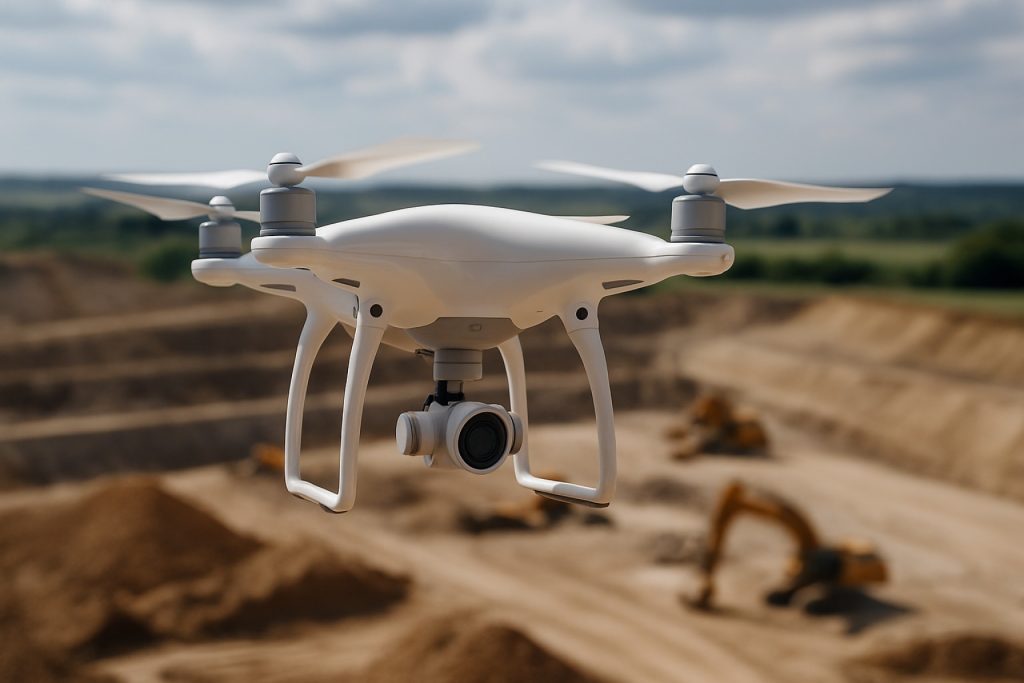
Autonomous Aerial Surveying Systems Market Report 2025: In-Depth Analysis of AI Integration, Market Dynamics, and Global Growth Prospects. Explore Key Trends, Forecasts, and Strategic Opportunities Shaping the Industry.
- Executive Summary and Market Overview
- Key Technology Trends in Autonomous Aerial Surveying Systems
- Competitive Landscape and Leading Players
- Market Growth Forecasts and Revenue Projections (2025–2030)
- Regional Analysis: Market Share and Emerging Hotspots
- Challenges, Risks, and Regulatory Considerations
- Opportunities and Strategic Recommendations
- Future Outlook: Innovations and Market Evolution
- Sources & References
Executive Summary and Market Overview
Autonomous aerial surveying systems refer to the integration of unmanned aerial vehicles (UAVs) equipped with advanced sensors, artificial intelligence (AI), and data processing capabilities to conduct geospatial surveys with minimal human intervention. These systems are revolutionizing industries such as construction, agriculture, mining, oil & gas, and environmental monitoring by providing rapid, accurate, and cost-effective data collection over large and often inaccessible areas.
The global market for autonomous aerial surveying systems is experiencing robust growth, driven by technological advancements in drone hardware, AI-powered analytics, and regulatory support for commercial UAV operations. According to Grand View Research, the commercial drone market is projected to reach USD 47.38 billion by 2025, with surveying and mapping applications constituting a significant share of this expansion. The adoption of autonomous systems is further accelerated by the increasing demand for real-time, high-resolution geospatial data and the need to reduce operational costs and safety risks associated with traditional manned surveys.
- Key Drivers: The primary drivers include advancements in AI and machine learning for automated flight planning and data analysis, improvements in battery life and sensor payloads, and the growing acceptance of UAVs in regulated airspace. Sectors such as construction and mining are leveraging these systems for volumetric analysis, progress tracking, and site inspection, while agriculture utilizes them for precision farming and crop health monitoring.
- Regional Trends: North America and Europe lead in adoption due to favorable regulatory frameworks and high investment in digital infrastructure. The Asia-Pacific region is witnessing rapid growth, propelled by large-scale infrastructure projects and increasing government initiatives to modernize surveying practices, as noted by MarketsandMarkets.
- Competitive Landscape: The market is characterized by the presence of established UAV manufacturers, specialized software providers, and integrated solution vendors. Companies such as DJI, Trimble, and senseFly are at the forefront, offering end-to-end autonomous surveying solutions.
Looking ahead to 2025, the autonomous aerial surveying systems market is poised for continued expansion, underpinned by ongoing innovation, regulatory clarity, and the growing imperative for digital transformation across asset-intensive industries.
Key Technology Trends in Autonomous Aerial Surveying Systems
Autonomous aerial surveying systems are rapidly transforming the geospatial and mapping industries by leveraging advanced technologies to deliver high-precision, efficient, and scalable data collection. As of 2025, several key technology trends are shaping the evolution and adoption of these systems.
- AI-Driven Data Processing: Artificial intelligence and machine learning algorithms are increasingly integrated into aerial surveying workflows. These technologies enable real-time object detection, automated feature extraction, and anomaly identification, significantly reducing manual post-processing time and improving data accuracy. Companies like DJI and senseFly are embedding AI capabilities into their platforms to streamline data analysis and deliver actionable insights faster.
- Edge Computing and Onboard Processing: The shift toward edge computing allows drones to process large volumes of imagery and sensor data onboard, minimizing the need for data transmission to ground stations. This trend enhances operational efficiency, especially in remote or bandwidth-constrained environments, and supports real-time decision-making in the field. Parrot and Teledyne FLIR are notable for integrating advanced processors and analytics directly into their UAVs.
- Multi-Sensor Integration: Modern autonomous aerial surveying systems are equipped with a combination of RGB cameras, LiDAR, multispectral, and thermal sensors. This multi-sensor approach enables comprehensive data capture for diverse applications, from topographic mapping to infrastructure inspection and environmental monitoring. Leica Geosystems and Trimble are leading the way in developing platforms that seamlessly integrate multiple sensor types.
- Enhanced Autonomy and Swarm Capabilities: Advances in navigation algorithms, obstacle avoidance, and fleet management software are enabling drones to operate with minimal human intervention. Swarm technology, where multiple UAVs coordinate autonomously, is gaining traction for large-scale surveys and rapid data acquisition. Skydio and Intel have demonstrated robust autonomous and swarm capabilities in commercial deployments.
- Cloud-Based Collaboration and Data Management: Cloud platforms are centralizing data storage, processing, and sharing, facilitating collaboration among stakeholders and supporting scalable project management. Solutions from Autodesk and Esri are widely adopted for integrating aerial survey data into broader geospatial workflows.
These technology trends are collectively driving the adoption of autonomous aerial surveying systems across industries, enabling faster, safer, and more cost-effective geospatial data collection in 2025.
Competitive Landscape and Leading Players
The competitive landscape for autonomous aerial surveying systems in 2025 is characterized by rapid technological innovation, strategic partnerships, and increasing market consolidation. The sector is dominated by a mix of established drone manufacturers, specialized software providers, and integrated solution vendors, all vying to capture a growing demand across industries such as construction, mining, agriculture, and infrastructure inspection.
Leading players include DJI, which maintains a significant market share due to its robust hardware portfolio and expanding enterprise solutions. DJI’s Matrice series, equipped with advanced sensors and AI-driven flight planning, continues to set industry benchmarks for reliability and data accuracy. Another key competitor, senseFly (a Parrot company), leverages its eBee platform to offer fixed-wing drones optimized for large-scale, high-precision mapping, particularly in agriculture and environmental monitoring.
On the software front, Pix4D and DroneDeploy are recognized leaders, providing cloud-based photogrammetry and analytics platforms that integrate seamlessly with a wide range of UAV hardware. These companies have focused on enhancing automation, real-time data processing, and AI-powered insights, which are increasingly demanded by enterprise clients seeking end-to-end solutions.
The market is also witnessing the rise of integrated solution providers such as Trimble and Leica Geosystems, both of which combine proprietary UAVs, sensors, and geospatial software to deliver turnkey surveying systems. Their strong presence in traditional surveying and construction markets gives them a competitive edge in cross-selling autonomous aerial solutions to existing clients.
Startups and regional players are contributing to innovation, particularly in AI-driven flight autonomy, obstacle avoidance, and regulatory compliance. Companies like Skydio are pushing the boundaries of autonomous navigation, while others focus on niche applications such as corridor mapping or volumetric analysis.
Strategic partnerships and acquisitions are shaping the competitive dynamics, with larger firms acquiring technology startups to accelerate R&D and expand their solution portfolios. According to Grand View Research, the global market is expected to see continued consolidation as leading players seek to differentiate through proprietary technology and comprehensive service offerings.
Market Growth Forecasts and Revenue Projections (2025–2030)
The global market for autonomous aerial surveying systems is poised for robust growth in 2025, driven by rapid advancements in drone technology, artificial intelligence, and geospatial analytics. According to projections by MarketsandMarkets, the aerial imaging market—which includes autonomous surveying platforms—is expected to reach a value of approximately USD 4.5 billion in 2025, up from USD 2.6 billion in 2020, reflecting a compound annual growth rate (CAGR) of over 12%. This surge is attributed to increasing adoption across industries such as construction, agriculture, mining, and environmental monitoring, where the demand for high-resolution, real-time geospatial data is accelerating.
In 2025, the commercial sector is anticipated to account for the largest share of revenue, with construction and infrastructure projects leading the way. The integration of autonomous aerial surveying systems into Building Information Modeling (BIM) workflows and digital twin initiatives is expected to streamline project management and reduce operational costs. Grand View Research highlights that the commercial drone market, a key segment for autonomous surveying, is projected to grow at a CAGR of 13.9% through 2025, with surveying and mapping applications representing a significant portion of this expansion.
Regionally, North America is forecasted to maintain its dominance in 2025, supported by favorable regulatory frameworks and substantial investments in smart infrastructure. However, Asia-Pacific is emerging as the fastest-growing market, propelled by large-scale infrastructure development in China, India, and Southeast Asia. IDTechEx reports that government initiatives and public-private partnerships in these regions are accelerating the deployment of autonomous aerial surveying systems for urban planning, disaster management, and precision agriculture.
- Key revenue drivers in 2025 include advancements in sensor payloads, improved data processing algorithms, and the proliferation of cloud-based analytics platforms.
- Service-based business models, such as drone-as-a-service (DaaS), are expected to gain traction, enabling organizations to access advanced surveying capabilities without significant capital investment.
- Ongoing regulatory developments, particularly in Beyond Visual Line of Sight (BVLOS) operations, are anticipated to unlock new market opportunities and further boost revenue growth.
Overall, 2025 marks a pivotal year for the autonomous aerial surveying systems market, setting the stage for sustained expansion and technological innovation through the end of the decade.
Regional Analysis: Market Share and Emerging Hotspots
The global market for autonomous aerial surveying systems is experiencing dynamic regional shifts, with market share increasingly concentrated in North America, Europe, and Asia-Pacific, while emerging hotspots in Latin America and the Middle East are gaining traction. In 2025, North America is projected to maintain its leadership, accounting for approximately 35% of the global market share, driven by robust investments in infrastructure, agriculture, and mining, as well as favorable regulatory frameworks for drone operations. The United States, in particular, benefits from the presence of major industry players and a mature ecosystem for drone technology adoption, as highlighted by Federal Aviation Administration data and industry reports from Grand View Research.
Europe follows closely, with a market share of around 28%, propelled by the European Union’s harmonized drone regulations and strong demand in construction, energy, and environmental monitoring sectors. Countries such as Germany, France, and the United Kingdom are at the forefront, leveraging advanced R&D capabilities and public-private partnerships to accelerate deployment. The European market is also characterized by a growing emphasis on sustainability and precision agriculture, as noted by European Commission initiatives.
The Asia-Pacific region is emerging as the fastest-growing market, with a CAGR exceeding 18% through 2025, according to MarketsandMarkets. China leads the region, fueled by aggressive government support, rapid urbanization, and the expansion of smart city projects. Japan, South Korea, and Australia are also notable for their adoption of autonomous aerial surveying in disaster management and infrastructure monitoring. The region’s growth is further supported by a burgeoning manufacturing base and increasing investments in AI-driven drone technologies.
- Latin America: Brazil and Mexico are emerging as regional hotspots, particularly in agriculture and mining. The adoption rate is accelerating due to cost-effective drone solutions and growing awareness of the benefits of autonomous surveying.
- Middle East & Africa: The Middle East, especially the UAE and Saudi Arabia, is investing in aerial surveying for urban planning and oil & gas applications. Africa’s market is nascent but shows promise in resource management and environmental monitoring, as reported by International Data Corporation (IDC).
In summary, while established markets in North America and Europe continue to dominate, the rapid expansion in Asia-Pacific and the emergence of new hotspots in Latin America and the Middle East are reshaping the competitive landscape for autonomous aerial surveying systems in 2025.
Challenges, Risks, and Regulatory Considerations
Autonomous aerial surveying systems, which leverage drones and advanced AI for data collection and analysis, are rapidly transforming industries such as construction, agriculture, mining, and environmental monitoring. However, their adoption in 2025 faces a complex landscape of challenges, risks, and regulatory considerations that stakeholders must navigate.
One of the primary challenges is the integration of autonomous systems into existing workflows. Many organizations struggle with interoperability between drone platforms, data processing software, and legacy systems, leading to inefficiencies and increased operational costs. Additionally, the reliability of AI-driven navigation and data interpretation remains a concern, particularly in environments with unpredictable weather, electromagnetic interference, or GPS-denied zones. These technical hurdles can compromise data accuracy and mission safety.
Cybersecurity risks are also escalating as drones become more connected. Autonomous aerial systems are vulnerable to hacking, data breaches, and signal jamming, which can result in the loss of sensitive geospatial data or even the hijacking of drones. According to European Union Agency for Cybersecurity (ENISA), the proliferation of IoT devices, including drones, has expanded the attack surface for malicious actors, necessitating robust encryption and secure communication protocols.
From a regulatory perspective, the landscape is highly fragmented and rapidly evolving. In 2025, authorities such as the Federal Aviation Administration (FAA) and the European Union Aviation Safety Agency (EASA) continue to refine rules governing beyond visual line of sight (BVLOS) operations, airspace integration, and remote identification requirements. Compliance with these regulations often requires significant investment in technology and training, particularly as standards differ across jurisdictions. For example, the FAA’s UAS Remote ID rule mandates real-time broadcast of drone identification and location, impacting both hardware design and operational protocols.
- Privacy concerns are intensifying, especially in urban and sensitive areas, as aerial surveys can inadvertently capture personal or proprietary information. This has prompted stricter data protection requirements under frameworks like the General Data Protection Regulation (GDPR).
- Insurance and liability issues are complex, with unclear fault attribution in the event of system failures or accidents involving autonomous drones.
- Environmental risks, such as wildlife disturbance and noise pollution, are increasingly scrutinized by regulatory bodies and local communities.
In summary, while autonomous aerial surveying systems offer significant efficiency and data quality benefits, their widespread adoption in 2025 is tempered by technical, cybersecurity, regulatory, and societal challenges that require coordinated industry and governmental responses.
Opportunities and Strategic Recommendations
The autonomous aerial surveying systems market in 2025 is poised for significant expansion, driven by rapid advancements in drone technology, artificial intelligence, and data analytics. Key opportunities are emerging across sectors such as construction, agriculture, mining, energy, and environmental monitoring, where the demand for high-precision, cost-effective, and real-time geospatial data is accelerating.
- Sectoral Expansion: The construction and infrastructure industries are expected to remain the largest adopters, leveraging autonomous aerial surveying for site planning, progress tracking, and asset management. However, agriculture is rapidly catching up, with precision farming and crop health monitoring creating new revenue streams for solution providers (Grand View Research).
- Technological Integration: Integrating AI-powered image recognition and cloud-based data processing will be a key differentiator. Companies that offer end-to-end solutions—from autonomous flight planning to automated data analysis—will capture greater market share. Partnerships with GIS and analytics software vendors can further enhance value propositions (MarketsandMarkets).
- Regulatory Evolution: Evolving regulations, particularly in North America and Europe, are gradually enabling beyond-visual-line-of-sight (BVLOS) operations. Early movers that invest in compliance and safety features will be well-positioned to scale operations as airspace rules liberalize (Federal Aviation Administration).
- Emerging Markets: There is untapped potential in Asia-Pacific, Latin America, and Africa, where infrastructure development and resource management are priorities. Local partnerships and tailored solutions for these regions can unlock new growth avenues (IDTechEx).
Strategic Recommendations:
- Invest in R&D for AI-driven data analytics and autonomous navigation to maintain technological leadership.
- Forge alliances with GIS, construction, and agricultural technology firms to offer integrated, sector-specific solutions.
- Prioritize regulatory engagement and certification to enable BVLOS and night-time operations.
- Expand into emerging markets through local partnerships and by addressing region-specific needs.
By capitalizing on these opportunities and executing targeted strategies, stakeholders can secure a competitive edge in the rapidly evolving autonomous aerial surveying systems market in 2025.
Future Outlook: Innovations and Market Evolution
The future outlook for autonomous aerial surveying systems in 2025 is marked by rapid technological innovation and expanding market adoption across multiple industries. As artificial intelligence (AI), machine learning, and edge computing become more deeply integrated into drone platforms, these systems are expected to deliver unprecedented levels of autonomy, data accuracy, and operational efficiency. The evolution from semi-autonomous to fully autonomous surveying solutions is being accelerated by advancements in real-time data processing, obstacle avoidance, and swarm intelligence, enabling drones to conduct complex missions with minimal human intervention.
One of the most significant innovations anticipated in 2025 is the deployment of AI-powered analytics directly onboard drones, allowing for immediate data interpretation and actionable insights during flight. This reduces the need for post-processing and shortens project timelines, which is particularly valuable in sectors such as construction, mining, and agriculture. Additionally, the integration of 5G connectivity is expected to enhance real-time communication between drones and ground stations, supporting larger-scale, coordinated operations and remote management capabilities Gartner.
Regulatory frameworks are also evolving to accommodate the growing use of autonomous aerial systems. In 2025, more countries are expected to implement streamlined approval processes for beyond visual line of sight (BVLOS) operations, which will unlock new commercial applications and drive market growth Federal Aviation Administration. This regulatory progress, combined with falling hardware costs and improved battery technologies, is projected to make autonomous aerial surveying more accessible to small and medium-sized enterprises.
- Global market revenue for drone-based surveying is forecasted to surpass $3.5 billion by 2025, with a compound annual growth rate (CAGR) exceeding 15% MarketsandMarkets.
- Key industry players are investing in modular payloads and open software ecosystems, fostering interoperability and customization for diverse surveying needs DJI.
- Emerging use cases include automated infrastructure inspection, precision agriculture, and environmental monitoring, all benefiting from enhanced autonomy and data fidelity IDC.
In summary, 2025 will see autonomous aerial surveying systems transition from niche tools to mainstream assets, driven by technological breakthroughs, regulatory support, and expanding application domains.
Sources & References
- Grand View Research
- MarketsandMarkets
- Trimble
- senseFly
- Parrot
- Skydio
- Esri
- Pix4D
- DroneDeploy
- IDTechEx
- European Commission
- International Data Corporation (IDC)
- European Union Agency for Cybersecurity (ENISA)
- European Union Aviation Safety Agency (EASA)
- General Data Protection Regulation (GDPR)



